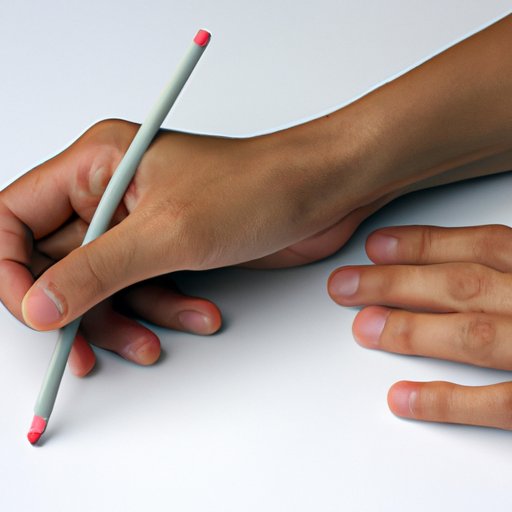Introduction
Have you ever struggled with your handwriting? Perhaps you feel like no matter how much you practice, your letters always come out sloppily and difficult to read. If that’s the case, then you might be surprised to learn that one of the biggest factors affecting handwriting is the way you hold your pencil. Holding a pencil correctly not only helps to improve handwriting but also helps to alleviate discomfort and fatigue when writing or drawing. In this article, we’ll share some tips and tricks for holding your pencil correctly. We’ll cover everything from the basics of pencil grip to more advanced techniques that can help you elevate your handwriting to the next level.

The Right Grip: A Guide to Holding Your Pencil Correctly
There are many different ways to grip a pencil, and some grips are more effective than others. A few examples include the tripod grip, the quadrupod grip, and the dynamic tripod grip. However, the most recommended grip is the tripod grip.
The tripod grip involves holding the pencil with the tips of the index finger, middle finger, and thumb. The other fingers are relaxed and may rest gently on the pencil. This grip provides stability and control while avoiding unnecessary pressure on the hand.
To achieve the tripod grip, follow these steps:
1. Hold the full length of the pencil in your hand with your fingertips
2. Rest the pencil on your middle finger and let it gently rest on the pad of your thumb
3. Use your index finger to steady the pencil and press it against your thumb to stabilize it
Visual aids can be very helpful when learning this gripping technique. If you’re visualizing and finding it difficult to see, search for images or videos to help you grasp the concept.
From Scribbles to Masterpieces: Mastering the Art of Pencil Holding
For beginners, mastering a proper grip might be challenging. However, there are a few tips and tricks that can help you improve your pencil holding skills over time:
1. Practice the tripod grip daily to make it more natural
2. Use wider pencils or crayons to assist in gripping
3. Experiment with different positions to see what feels most comfortable
4. If needed, adjust the grip to suit your preference, but always keep in mind the fundamentals of good grip
Practice might not make perfect, but it makes better. Therefore, the more practice you put into improving your grip, the more it will become second nature. It’s also good to know that your grip will change over time, and that’s okay.
Artists understand the importance of holding a pencil correctly. According to Pablo Picasso, “Learn the rules like a pro, so you can break them like an artist.” Remember that your goal is not only to have neat handwriting but also to make your unique mark more defined.
3 Easy Steps to Improving Handwriting by Learning the Proper Pencil Grip
A proper pencil grip not only helps with the legibility of your writing but also improves the look of your letters. Here are three easy steps to follow to help you master the proper grip for improved handwriting.
Step 1: Hold the pencil in the tripod grip using the technique we already outlined.
Step 2: Write out some sentences using your newly acquired grip, applying firm but not excessive pressure on your pencil.
Step 3: Practice keeping your grip relaxed and steady until it feels natural.
Over time, your handwriting will become neater and more consistent as your grip becomes more relaxed and natural.
Pencil Power: Maximizing Control and Comfort in Your Handwriting
Improving your grip can provide you with more control and comfort when writing or drawing. Stronger grip strength can also reduce hand fatigue and pressure on your joints.
Here are a few tips for maximizing control and comfort:
1. Improve muscle strength in your fingers by squeezing putty or a stress ball.
2. Practice writing or drawing daily to help build grip strength.
3. Experiment with using different parts of your hand, such as your fingertips or the heel of your hand, to add more stability and comfort when writing.
Keep in mind that your grip will change from time to time, and when discomfort arises, adjust your grip to optimize your writing quality.
Write It Right: Tips and Tricks for Holding Your Pencil Like a Pro
At this point, you may have already mastered the tripod grip and understand the benefits of a proper grip. However, there are other grips you can use depending on the intent of your writing or drawing.
For writing tasks, the dynamic tripod grip is often the best choice. This grip provides a balance of stability and flexibility that is essential when writing for longer periods. For drawing and shading, a looser grip that allows more freedom is useful.
Here are some tips for practicing advanced grips:
1. Experiment with different grips and adjust to what works best.
2. If you’re left-handed, there are special grips you can use to suit your needs.
3. Consider using a thicker barrel pencil or grip to help with comfort.
Remember that everyone has a different style and should work to develop a grip that works best for them, even if it challenges traditional recommendations.
Unlock the Secret to Neat Handwriting with the Correct Pencil Grip
A proper pencil grip can lead to more legible and neater handwriting. A good grip should provide you with the control and stability you need to write with ease.
Here are some real-life examples of people who improved their handwriting by adjusting their grip:
1. Sarah, a teacher, struggled with her cursive writing until she started using the tripod grip. It took a month of daily practice but made a significant improvement.
2. David, a student, found that he was gripping the pencil too tightly and had to loosen his grip to achieve more comfortable handwriting.
Remember, practice makes better — not perfect, but much better.
Conclusion
In conclusion, holding a pencil correctly is essential not only for improving handwriting but also for reducing discomfort and hand fatigue. It’s important to experiment with different grips to see what works best for you and keep in mind the benefits of a good grip. Use wider pencils or a pencil grip, practice controlling your grip, and squeeze putty or try exercises to build strength.
